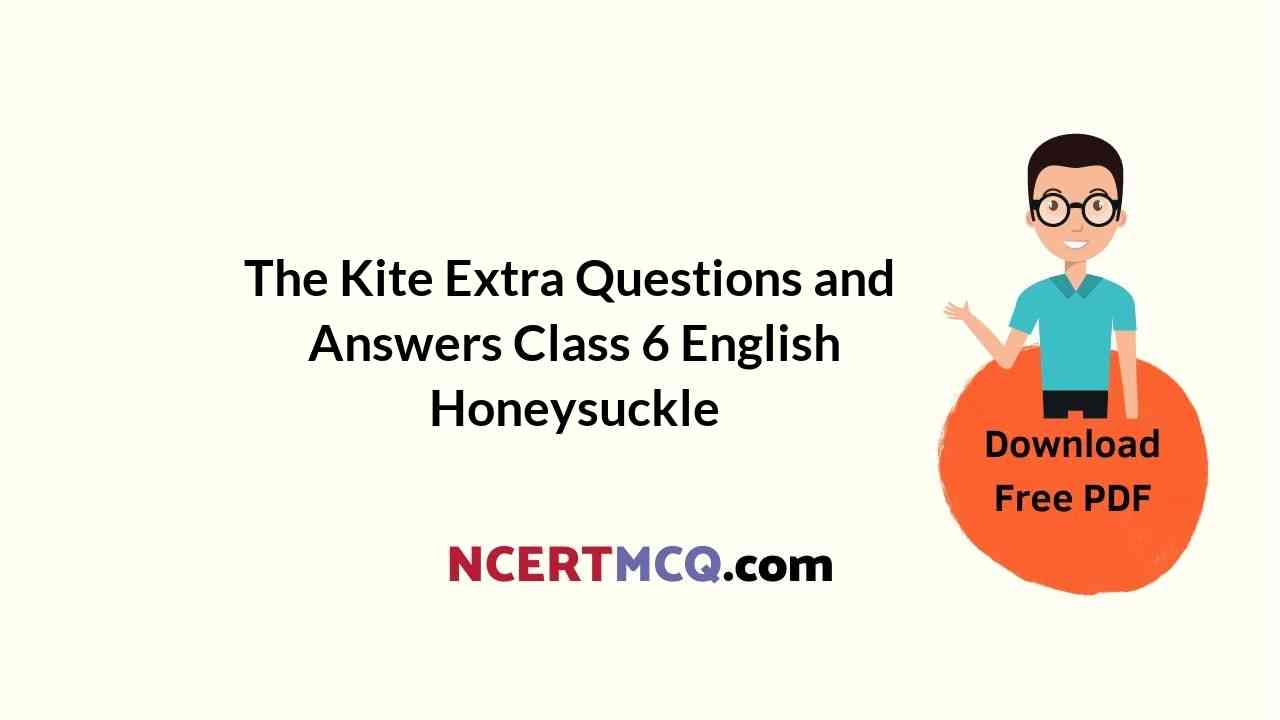Here we are providing the Kite Extra Questions and Answers Class 6 English Honeysuckle, Extra Questions for Class 6 English was designed by subject expert teachers. https://ncertmcq.com/extra-questions-for-class-6-english/
The Kite Extra Questions and Answers Class 6 English Honeysuckle
The Kite Tree Extra Questions and Answers Short Answer Type
The Kite Poem Class 6 Questions And Answers Question 1.
List out the action words in the poem, dive, dip, snaps.
Find out the meaning of these words.
Answer:
Soars, rides, climbs, pulls, falls, run, blows, goes, see flaps, fill.
Student should consult “Word Meaning” For meanings of these words.
The Kite Poem Questions And Answers Question 2.
Read these lines from the poem Then soars like a ship
With only a sail
The movements of the tailless kite is compared to a ship with a sail. This is called a simile. Can you suggest what who the following actions may be compared to?
He runs like (a) …………
He eats like (b) …………
She sings like (c) …………..
It shines like (d) …………..
It flies like (e) ………………
Answer:
(a) horse snail
(b) elephant
(c) canary
(d) diamond
(e) a bird.
The Kite Question Answer Question 3.
Try to make a kite with your friends. Collect the things required for such as colour paper/ newspaper thread, glue, a thin stick that can be bent. After making the kite see if you can fly it.
Answer:
Do it yourself.
The Kite Tree Extra Questions and Answers Reference of Context
The Kite Class 6 Questions And Answers Question 1.
How bright on the blue
Is a kite when it’s new!
With a dive and a dip
It snaps its tail
Then soars like a ship
With only a sail
As over tides
Of wind it rides,
Climbs to the crest
Of a gust and pulls,
Then seems to rest
Explanation
A kite attracts and fascinates its viewer by its beauty. The beauty of being new and fluttering in the bright sky. Its dives and dips trailed by its tail is a treat to watch. It rides the wind as does a ship soars on the waves in an ocean. The flow of wind takes away the ship sailing with one sail is compared with the flight of a kite. Ships travels on tide so does a kite fly on wind. It goes up and down as flows the wind.
(i) What does the opening line suggests?
(ii) What makes the tail ‘snap’?
(iii) What does the ‘soar’ mean?
(iv) When is ‘crest’ reached?
(v) Who ‘seems to rest’ when wind slows down?
Answer:
(i) The opening lines suggests that it was a new kite.
(ii) Due to dipping of kite in the air makes the tail ‘snap’.
(iii) The meaning of‘soar’is rise.
(iv) The ‘crest’ is reached when wind blow.
(v) The kite seems to rest when the wind slows down.
Class 6 English The Kite Question Answer Question 2.
As over tides
Of wind it rides,
Climbs to the crest
Of a gust and pulls,
Then seems to rest
As wind falls
When string goes slack
You wind it back
And run until
A new breeze blows
Explanation
When the string starts loosening up one should wind it back to avoid entangling of it. When the wind starts blowing again, it flies again. The poet compares it with the wings of a bird.
(i) What does the word ‘slack’ means?
(ii) What change ‘a new breeze’ brings to the kite?
(iii) Whose ‘wings’ fill and goes up?
(iv) What one can do when string gets lose?
(v) Give the antonym of ‘blow’.
Answer:
(i) The word ‘slack’ mean is loose.
(ii) A new breeze brings changes as it makes it fly high.
(iii) Wings of kites fill and goes up.
(iv) When string gets loose, one must wind it back.
(v) Calm.
The Kite Poem Class 6 Extra Questions And Answers Question 3.
And its wings fill
And up it goes!
How bright on the blue
Is a kite when it’s new!
But a raggeder thing
You never will see
When it flaps on a string
In the top of a tree.
Explanation
When a kite comes down, it gets stuck up and tom in tree. Sometimes only the sound of its flapping is heard. One might not see it when it is tom yet it flutters because of the wind.
(i) Name the poet of the. poem.
(ii) What is the name of the poem?
(iii) What happens when string gets lose?
(iv) What can’t be ‘seen by the reader?
(v) What is the meaning of ‘raggeder’?
Answer:
(i) The name of the poet is Herry Behn.
(ii) The name of the poem is The kite
(iii) fWhen its strings struck up in branches, it starts flapping.
(iv) The reader can’t see the tom kite.
(v) Rags.
